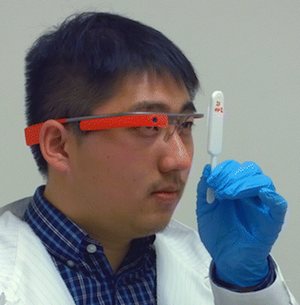Medical personnel have been spending several hours testing Google Glass in labs to get a better understanding of the device’s hardware and software capabilities.
When using the device with cadavers to practice procedures, It became clear how easily Glass could be integrated into the anatomy lab by medical students.
Google Glass can be made to read QR codes, and then use use this information to link to online content.Anatomy instructors could essentially tag anatomical parts with QR codes and then use this feature for a wide variety of functions.
For The Learning Process:
When an anatomical part is tagged in the traditional sense, it’s often done with a number because it’s difficult to spell out the entire name on a small piece of paper. The limited space makes it difficult to put any other crucial information as well. Using QR codes, medical school instructors could tag anatomical parts and then link that to robust multimedia and improve learning — not just the name of the anatomical part.I’ll give an example. When medical students are doing the musculoskeletal block , we had to learn not only the anatomical part, but what a particular muscle did. If the deltoid muscle was tagged with a QR code, a medical student could use Glass to read the QR code, and then be presented with rich multimedia that would show them the muscle is innervated by the axillary nerve. They would be presented with videos and pictures of the various functions of the muscle and also the clinical significance — right at the bedside. This rich multimedia presentation of content is so far ahead of what medical students get today in the anatomy lab. This would enable Glass to essentially do bedside teaching for every anatomy student there, without the need to have an instructor holding their hand through every step.
For Testing Procedures:
QR codes could also be used for testing. During anatomy practicals, instructors could identify anatomical parts and then ask test questions on google glass. This part would be a lot harder to do since questions are not usually multiple choice, and there would have to be strict procedures and policies in place for testing. I’m excited to see if Google Glass will be embraced by medical schools in the anatomy lab since it could offer a different level of learning that was only dreamed of before.Already In Use By Health Practitionals
Boston hospital Beth Israel Deaconess Medical Centre has used Google Glass to check patient records via QR codes displayed on their room doors and keep doctors' hands free when checking details online.Doctor Steven Horng has credited the device with helping to save a patient's life who was suffering a brain hemmorrhage. Dr Horng was able to instantly check the man's medical history, who was allergic to a specific kind of blood pressure drug regularly issued to prevent bleeding, without having to leave him to leaf through papers.
The benefits continues to pile. Why not benefit from this treasure box from innovative wearable technology.
Read Also








I'm truly enjoying the design and layout of your site. It's a very easy on the eyes which makes it much more enjoyable for me to come here and visit more often. Did you hire out a developer to create your theme? Outstanding work! orthodontists in birmingham al
ReplyDelete